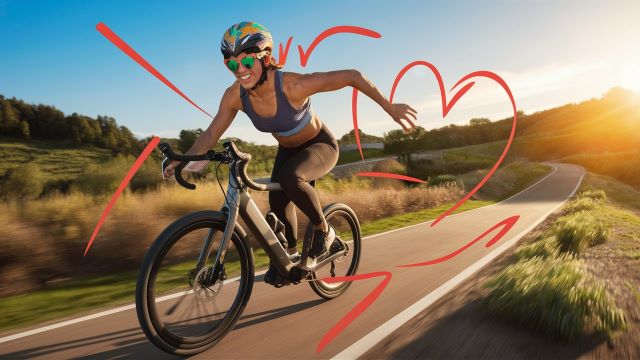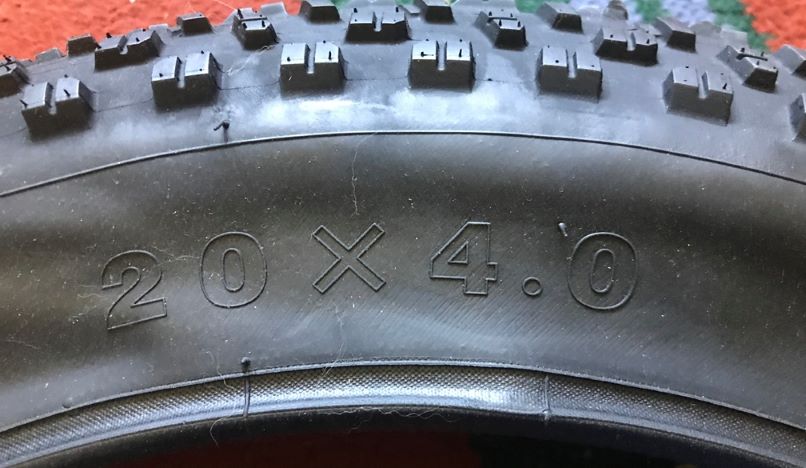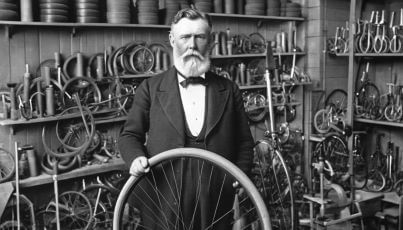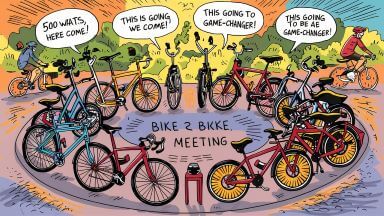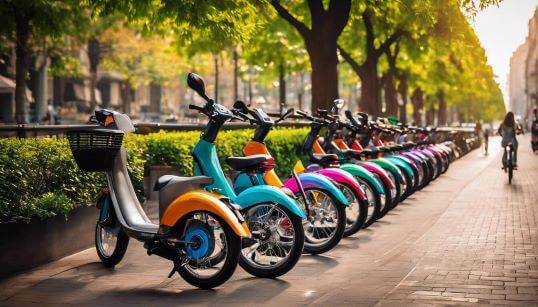Transporting you to your childhood, unfolding for your first time cycling in years to the nostalgia in the most fitness-oriented manner – biking is back! Welcome back on the saddle after years, or perhaps decades, and find just why cycling still holds magic. It’s no surprise if your heart is racing at the thought of that first-time ride again, if you are a first-time rider or a beginner once again I’ve written some thoughts about my tips for getting back on the bike.
So I myself got back into cycling in my late 40s I did ride a normal mounting bike at the start but it became too exhausting, so I got myself a Moscow 48v electric bike and never looked back, I would say if you cycled before you have nothing to worry about, all I would say is be careful and don’t rush, the only times Ive nearly been in an accident were when I was rushing, more advice in this article to help you.
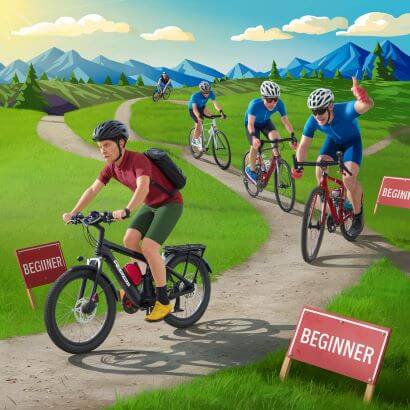
However, as the old saying goes, it’s as easy as…well, riding a bike. Our comprehensive guide will provide essential tips and advice for beginners to get those wheels spinning with confidence and safety. Pedal forward into this exciting journey as we cover everything from choosing the right bike to navigating through city streets, all while ensuring fun is at the forefront of your biking adventure!
When getting back into cycling after an extended hiatus, it is important to take certain precautions. Start by riding at an easier pace for the first 10-15 minutes to warm up and gradually build endurance. It is normal to feel tired, nauseous, and have sore legs initially, but these will subside after a few rides.
It is advisable to begin with flatter routes and then gradually introduce inclines and hills over time. Make sure your bike fits you properly and familiarise yourself with gear ranges for optimal performance. If needed, you can even opt to walk up hills initially before cycling from there. Remember, with consistent effort, it will become easier, and you’ll soon be able to overcome challenges that previously seemed difficult.
Preparing for Your Cycling Return
Before you embark on your cycling journey after years of being away from the saddle, it’s essential to take a few preparatory steps. Firstly, it’s important to manage your expectations and understand that it may take some time for your body to adjust to the physical demands of cycling. Don’t be discouraged if you feel tired, nauseous, or have sore legs after the first ride – this is perfectly normal, especially if you haven’t been engaging in consistent fitness workouts for years, also let’s be clear your ass is going to hurt at first and be very sore until you get used to it from the saddle, you could get your gf or wife to harden it up a bit with some slapping on the ass though ha.
Remind yourself why you are doing this, its for leisure and to get out of the house, you are not riding in the Tour De France, its not a competition, its fine to be competitive, but remember it is supposed to be FUN!
I have an exercise bike or trainer at home I used to practice using this at home, you can try this it will get you into the habit of cycling and moving your legs, it will not improve your balance though, which may be something that comes back naturally, or may take some practice, I did not have any problems balancing on the bike though.
- Before starting your cycling journey after a long break, it is important to manage your expectations and understand that it may take time for your body to adjust. Feeling tired, nauseous, or having sore legs after the first ride is normal. Start by riding easily for the first few minutes to warm up and prevent muscle strain. Invest in proper cycling gear, including a secure and comfortable bike helmet and padded shorts to reduce discomfort. Finally, choose the right bike for your needs.

Choosing the Right Bike
Selecting the appropriate bike for your needs is paramount when getting back into cycling. With various types of bikes available in the market, it can be overwhelming, but fear not! Consider these factors to make an informed decision:
- Right (Electric) bike: I think most older people who get back into cycling are choosing an ebike, for one good reason it helps you back into the sport, rather than cycling for a few miles and feeling like you are having a heart attack, get a bike that suits your posture and aliments.
- Frame: It’s crucial to ensure your bike fits you properly to prevent discomfort and potential injuries. Consider some of the bikes where you can sit up, the fat tyre bikes, for example, allow you to sit up with your back straight, whereas on a mountain bike and a racing bike, you are bent over, if you are like me and old this is not good!
- Gearing: Different bikes have different gear systems. The only issue you may have if you are using an e-bike is that sometimes it may feel like the bike is going to stall, if you find this go into a much lower gear and spin the pedals faster as if you are pedalling slowly the speed sensor does not always pick up the cadence properly, choose a lower gear and spin the pedals like Lance Armstrong used to! if you are using an electric bicycle, you don’t need to worry too much about gears, it depends on your terrain of course but most ebikes will go out most hills in most gears, just practice changing them each bike is different you will get used to it.
- Budget: Honestly start with a cheap bike, don’t spend 4 grand on a new electric bike even though you are tempted, buy a cheaper one around £1000 is going to be the lowest you can go, you can always sell and upgrade that’s what I did.
Picking Beginner-friendly Routes
When you’re just getting started with cycling after a long hiatus, don’t try to cycle 30 miles on your first trip, the most you should be starting with is 5 miles, start with an easy bike ride on a flat bike path, and take it from there, once you have mastered the flat plan some more ambitious rides, get out into the fresh air and countryside and enjoy the scenery, take some food with you and drink plus some cash.
Consider exploring local parks or recreational areas that offer dedicated cycling paths. These trails are often well-maintained and designed with the safety and enjoyment of cyclists in mind. They also tend to be surrounded by scenic landscapes, allowing you to enjoy the ride while immersing yourself in nature.
For instance, if you haven’t been engaging in regular fitness workouts for years, it might be wise to begin with shorter rides at a comfortable pace, gradually increasing both distance and intensity as you regain strength and develop confidence. Remember, progress is measured through personal achievements rather than comparison to others.
By setting attainable goals, you’ll experience a sense of accomplishment with each milestone reached, fuelling your motivation to continue the journey. Don’t forget to celebrate these achievements along the way!
If you live in an urban area, look for cycling maps or resources provided by your local government or cycling associations. These resources often highlight bike-friendly routes and low-traffic options, making it easier for beginners to navigate safely through the city.
Remember that starting off with shorter distances and gradually increasing the length of your rides is key to avoiding exhaustion and preventing muscle soreness. Also, don’t hesitate to mix things up and explore different routes to keep your cycling experience fresh and exciting.
Now that you’ve identified some beginner-friendly routes, let’s discuss the essential gear you’ll need to ensure a safe and comfortable cycling journey.
- According to a 2021 survey by YouGov, 52% of participants stated that starting slowly and gradually increasing the intensity of their riding was the best advice they had received when returning to cycling after a significant period.
- The American Heart Association recommends at least 150 minutes per week of moderate-intensity aerobic activity such as cycling, but research shows that only about 20% of US adults are reaching this goal.
- A 2019 study published in the Journal of Transport & Health found there is a nearly 20-fold increase in adverse events (like muscle strains or crashes) for novice cyclists in their first month compared to more experienced riders. So focusing on safety and proper technique early on is particularly crucial.
Essential Cycling Gear
As a beginner cyclist, investing in essential gear can greatly enhance your riding experience. Here are a few must-have items:
- Helmet: The most important piece of gear for both safety and legal reasons. Choose one that fits properly and provides adequate protection.
- Comfortable clothing: Opt for moisture-wicking fabrics that keep you cool and dry during your rides. Consider padded cycling shorts to minimise discomfort during longer trips.
- Cycling shoes: While not necessary for all beginners, they can improve pedalling efficiency and provide better grip on the pedals. Start with a basic pair and upgrade as you progress.
- Water bottle and cage: Staying hydrated is crucial, so make sure to have a water bottle within reach during your rides. Attach a bottle cage to your bike frame for easy access.
- Basic repair kit: Carry essentials like a spare inner tube, tyre levers, a small pump or CO2 inflator, and a multi-tool in case of minor repairs or adjustments while out on the road.
- Lights and reflectors: Ensure you are visible to other road users, especially when riding in low-light conditions or at night. Use front and rear lights along with reflective accessories.
Remember that as you progress in your cycling journey, you may find the need for additional gear such as cycling gloves, sunglasses, or even a bike computer to track your performance. However, these items are not essential for beginners and can be added gradually based on your specific needs and preferences.
Embracing the Journey: Tips for Long-term Enjoyment
Cycling isn’t just about reaching specific goals; it’s also an opportunity to explore new surroundings, enjoy the freedom of being outdoors, and prioritise your overall well-being. To ensure long-term enjoyment of your cycling experience, consider the following tips:
- Variety is key: Spice up your rides by exploring different routes and terrain. Look for scenic trails, urban landscapes, or challenging hills – diversity keeps things interesting and prevents monotony. But plan your route before you go or have a goal in mind.
- Ride with purpose: Don’t limit yourself to one reason for cycling. Ride for fun, health benefits, commuting purposes, stress relief, exploration, or even as a form of meditation. Embrace the versatility that cycling offers.
- Connect with fellow cyclists: Seek out local cycling groups or join online communities to connect with like-minded individuals who share your passion for seeking. The camaraderie and shared experiences can enhance your journey and provide valuable support and advice.
- Be mindful of self-care: Prioritise your physical and mental well-being by incorporating proper nutrition, hydration, and rest into your cycling routine. Listen to your body’s needs and adjust your rides accordingly.
- Enjoy the process: Cycling is not just about the destination; it’s about enjoying every moment of the ride. Take in the sights, sounds, and sensations as you pedal. Embrace the feeling of freedom and rejuvenation that cycling brings.
Remember, cycling is a journey, and like any journey, there will be ups and downs along the way. Embrace the challenges, learn from them, and keep pushing forward. As you continue to cycle regularly, you’ll develop a deeper appreciation for this fulfilling activity and witness remarkable improvements in your fitness levels and overall well-being.
What are some tips for easing back into cycling after a long period of inactivity?
Some tips for easing back into cycling after a long period of inactivity include starting with shorter rides to build endurance gradually, investing in a comfortable saddle and appropriate gear, wearing a helmet for safety, and incorporating cross-training exercises to improve overall fitness. According to a study by the University of East Anglia, regular cycling can improve cardiovascular health and reduce the risk of chronic diseases like heart disease and diabetes.
Are there any recommended training programmes or resources available for new cyclists looking to get back into the sport?
Yes, there are several recommended training programmes and resources available for first-time cyclists looking to get back into the sport. One highly recommended resource is a cycling app called Zwift, which offers structured training plans suitable for beginners. These plans focus on gradually increasing endurance, building strength, and improving technique. Additionally, many local cycling clubs and bike shops offer group rides or beginner-friendly cycling clinics that can provide valuable guidance and support. According to a study by Sports Medicine Australia, structured training programmes can significantly improve cardiovascular fitness and overall cycling performance in beginners within a short period of time.
Are there any specific safety precautions that returning cyclists should be aware of?
Yes, there are several important safety precautions that first-time cyclists should be aware of. Firstly, always wear a properly-fitted helmet to protect against head injuries – studies have shown that wearing a helmet can reduce the risk of head injury by up to 85%. Additionally, be visible to others on the road by wearing bright clothing and using lights, especially when cycling during low light conditions. Furthermore, make sure to follow traffic laws, signal your intentions clearly, and stay alert for potential hazards. Lastly, it’s essential to keep the bike in good condition by checking the brakes, tyres, and ensuring proper reflectors are installed. Remember, prioritising safety will enhance your cycling experience while reducing the risk of accidents.
What type of gear and equipment should first time cyclists invest in?
First-time cyclists should invest in a few essential pieces of gear and equipment. Firstly, a comfortable helmet is a must to ensure safety on the road. Secondly, padded cycling shorts can provide extra cushioning and prevent chafing during long rides. Additionally, a properly fitted bicycle with gears suitable for the terrain can make the cycling experience smoother and more enjoyable. According to statistics from the National Highway Traffic Safety Administration, helmets can reduce the risk of head injury by 85%, highlighting their importance for beginners venturing into cycling after years.
How can returning cyclists improve their endurance and prevent muscle soreness?
To improve endurance and prevent muscle soreness, first-time cyclists should focus on gradually increasing their ride duration and intensity. Incorporating strength training exercises, specifically targeting the muscles used while cycling, can also help build endurance and prevent soreness. Additionally, proper nutrition and hydration before, during, and after rides are crucial for optimising performance and reducing muscle fatigue. According to a study published in the Journal of Strength and Conditioning Research, consuming a carbohydrate-rich snack 30 minutes before exercise can improve endurance by 7-12%. Building up riding stamina gradually while taking care of muscle recovery can lead to long-lasting improvements in endurance and reduce the risk of soreness.
I'm the passionate mind behind this online web shop. As an avid cyclist, I have a particular fondness for electric bikes and scooters, believing they offer a unique sense of freedom and joy. Not only do I enjoy riding them, but I also take pride in reviewing and sharing my insights about these fantastic machines. Additionally, as someone who suffers from dry eyes, I'm committed to stocking products that genuinely enhance and improve people's lives. Dive into my shop, and you'll find a curated selection of e-bikes, scooters, and other life-enhancing products that I stand by.

